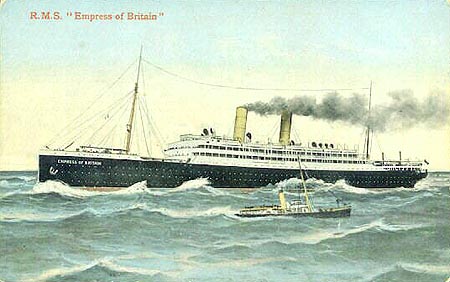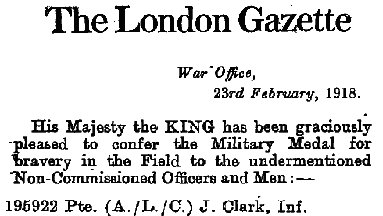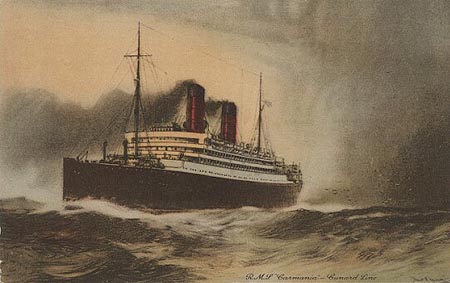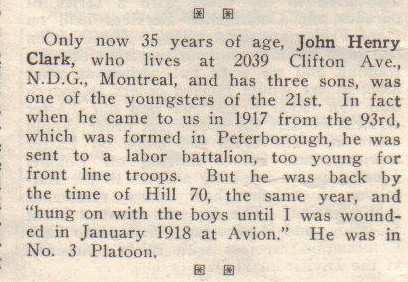|
Mar 21, 1899
|
Born at Wales
Ontario to James and Nellie Clark (nee Degray)
Note that the town of Wales Ontario
no longer exists, as it was flooded to create the St Lawrence Seaway
|
|
May 6, 1916
|
Attested into
the 93rd Battalion at Peterborough Ontario
Ø Number 195922
Ø Next of kin given as James S Clark (father) of 100 Dublin St,
Peterborough Ontario
Ø Previous occupation given as Assistant Operator
o Later changed to read Cinema Operator
Ø No previous military experience given
Ø Religion given as Presbyterian
|
|
Jul 15, 1916
|
Embarked the RMS
Empress of Britain Halifax Nova Scotia

|
|
Jul 25, 1916
|
Disembarked at
Liverpool England
|
|
Aug 12, 1916
|
TOS (Taken On
Strength) the CCAC (Canadian Casualty Assembly Centre) at Otterpool and shown to be On
Command to the 93rd Battalion for PBD (Permanent Base Duty) as a result of
being underage
|
|
Oct 6, 1916
|
Posted to the 39th
Reserve Battalion at West Sandling Camp and attached to the 3rd CTB (Canadian
Training Battalion) for Base Duty
|
|
Jan 4, 1917
|
Attached to the
6th Reserve Battalion
|
|
Jan 31, 1917
|
Attached to the
COC (Canadian Ordnance Corps) at Ashford
|
|
Feb 15, 1917
|
Admitted to the
VAD (Voluntary Aid Detachment) Hospital at Ashford diagnosed with Tonsillitis
|
|
Mar 3, 1917
|
Discharged to
duty from hospital
|
|
Mar 5, 1917
|
Ceased to be
attached to the COC and returned to the 6th Reserve Battalion
|
|
Mar 11, 1917
|
TOS the EORD
(Eastern Ontario Regimental Depot) but remained attached to the 6th Reserve
Battalion
|
|
Jun 19, 1917
|
Posted to the 21st
Battalion
|
|
Jun 20, 1917
|
Arrived at No 2
CIBD (Canadian Infantry Base Depot) in France and TOS the 21st Battalion
|
|
Jul 8, 1917
|
Left 2 CIBD and
joined the 2nd Entrenching Battalion
|
|
Aug 20, 1917
|
Left the 2nd
Entrenching Battalion and joined the 21st Battalion in the field
The Battalion was in billets at
Fosse 10 cleaning up following a raid on the enemy lines a few days earlier.
Assigned to “A” Company,
No 3 Platoon
|
|
Nov 11, 1917
|
During the
fighting at Passchendaele he was subjected to a gas attack, although not hospitalized
|
|
Dec 5, 1917
|
Announced in the
2nd Canadian Division Routine Orders that A/L/C JH Clark is to receive the
Military Medal
There is no
mention in the file as to when he was appointed to the rank of Acting Lance Corporal
|
|
Jan 12, 1918
|
The Battalion
paraded at Westrehem where Lieut General Sir Arthur Currie KCB, KCMG, presented Acting
L/Cpl Clark with the riband of the Military Medal for his actions on November 11, 1917
|
|
Jan 26, 1918
|
Received
shrapnel wounds to arms, face and chest and admitted to No 5 CFA (Canadian Field
Ambulance). He was transferred the same day
to No 18 CCS (Casualty Clearing Station)
|
|
Jan 27, 1918
|
Transferred via
No 20 AT (Ambulance Train)
|
|
Jan 28, 1918
|
Admitted to No 1
Canadian General Hospital
|
|
Jan 29, 1918
|
Invalided to
England aboard the Hospital Ship Stad Antwerpen

Posted to the
EORD Seaford while in hospital and admitted to the King George Hospital, Stamford Rd,
London
|
|
Feb 8, 1918
|
Transferred to
the Manor War Hospital, Epsom
|
|
Feb 14, 1918
|
Transferred to
the Military Convalescent Hospital at Epsom
|
|
Feb 23, 1918
|
Military Medal
announced in the London Gazette No 30540

The citation
reads;
“For
conspicuous bravery on the 11th November.
This NCO was in charge of a party of stretcher bearers evacuating wounded from the
front line. When carrying out a wounded man
the party came under an intense bombardment. By
his splendid example he steadied his party and managed to evacuate the casualty who
required immediate attention, thereby saving his life.
On the return trip a direct hit was made on his party killing two and wounding
three. L/Cpl Clark with the remaining
unwounded men carried the three wounded men to the dressing station, over a mile away
working constantly under heavy shell fire and gas for fourteen hours. He then returned to the trenches where he carried
on with his duty, setting an excellent example to the remaining men.”
|
|
Mar 1, 1918
|
Transferred to
the Manor War Hospital, Epsom
Developed
acute Mastoiditis behind left ear.
|
|
Mar 30, 1918
|
Surgery was
performed to relieve the drainage from behind his left ear
|
|
Apr 5, 1918
|
Transferred to
No 3 CCD (Canadian Convalescent Depot) at Seaford
|
|
May 22, 1918
|
Transferred to
the Military Convalescent Hospital at Woodcote Park, Epsom
|
|
Jun 17, 1918
|
Began a regimen
of Physical Training and exercise
|
|
Jul 3, 1918
|
Discharged to
duty
|
|
Sep 5, 1918
|
TOS 6th
Reserve Battalion at Seaford on discharge from No 3 CCD
|
|
Dec 12, 1918
|
On Command to 3
Wing, Kinmel Park, Witley, pending return to Canada
|
|
Feb 1, 1919
|
Embarked the SS
Carmania at Liverpool

|
|
Feb 9, 1919
|
Disembarked at
Halifax Nova Scotia and proceeded to Kingston Ontario
|
|
Feb 11, 1919
|
Posted to the
Military District No 3 Casualty Company at Kingston Ontario
|
|
Feb 12, 1919
|
Granted leave
with subsistence until February 25, 1919
|
|
Feb 26, 1919
|
Medical Board at
the Barriefield Camp, Kingston, notes the following
Ø Hoarseness and partial loss of voice from chronic Laryngitis. This has been constant since November 1917 when he
was gassed
Ø Suffers from ringing
in the ears caused from a concussion received from a shell exploding near him which caused
shrapnel wounds to his face, both arms and chest
Ø His condition is considered to be permanent
|
|
Mar 6, 1919
|
Discharged from
the CEF at Kingston Ontario
Rank on Discharge – Pte
Proposed residence on discharge – 100 Dublin St, Peterborough
Ontario
|
|
Apr 28, 1927
|
British War
Medal, Victory Medal and Military Medal sent to him at 593 Old Orchard Ave, NDG Montreal
Quebec

Above is from the July 1935 issue of the Communiqué, the 21st
Battalion post war newsletter
|
|
|
Pte John Henry
Clark, MM, died at North Lancaster Ontario in 1970
|